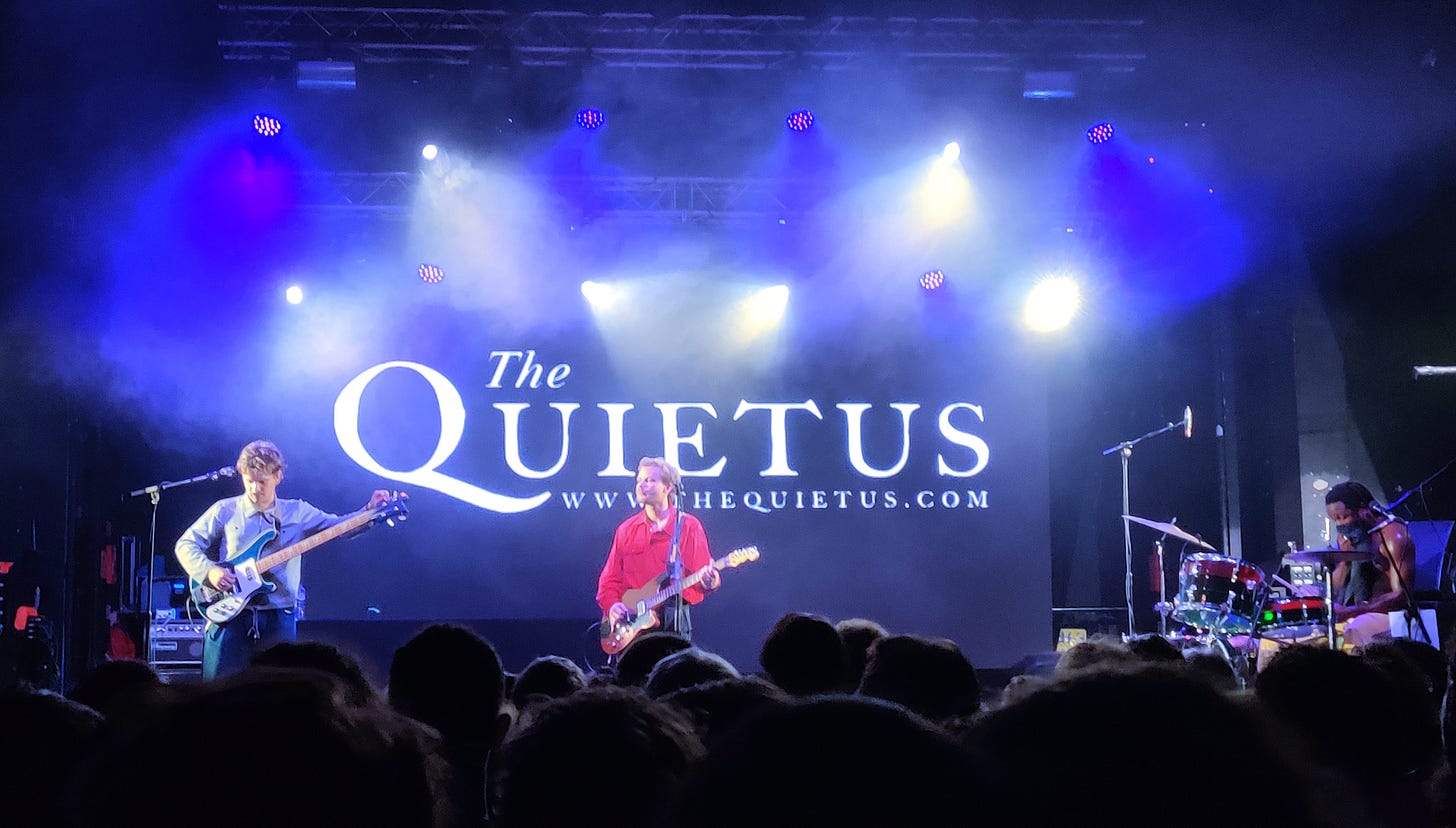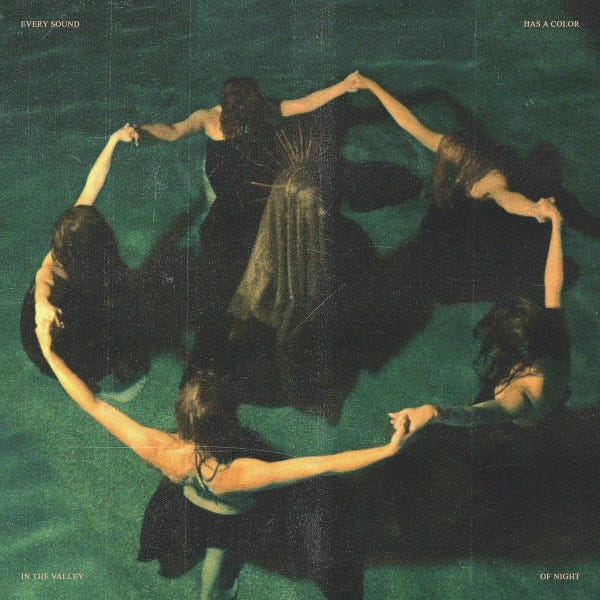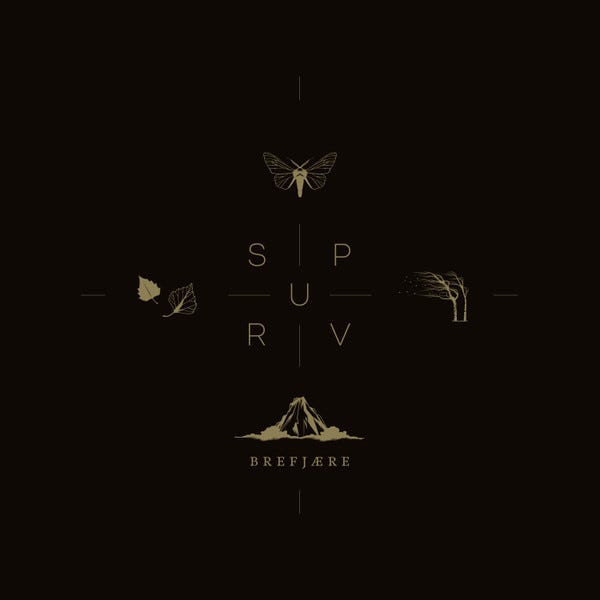October 2023: Of (Virtual) Reality - Ludomusicology
Post-video game music, black midi live, and new releases from Night Verses and Spurv
Music for gaming… or gaming for music?
TesseracT’s latest album War Of Being was released this month. It’s good, probably their best work to date, building off the confidence of their slick P O R T A L S live album/film. Intriguingly, the release of early single The Grey coincided with the early-access release of a tie-in first-person VR & desktop video game, also named War Of Being.
Video game tie-ins to music releases are rare but not unheard of - with recent proponents including Weezer, Anamanaguchi, and Cult Of Luna. (There’s a list of some of the older and weirder ones in this article.) Generally they’re… not good? I enjoyed the Cult Of Luna release, but it was mostly just an extended version of Cold Burn playing whilst you picked up shiny white objects in a grey 3D world, and probably 95% of that enjoyment was because Cold Burn is an amazing track. Anamanaguchi (sort of?) released a video game a few years back called Capsule Silence XXIV, except it was more of a bizarre kayfabe hoax around a dispute with a fictional triple-A game developer that massively backfired with fans; its gameplay mostly consisted of finding cassette tapes with music from the tie-in album in a deliberately broken game world.
Let’s caveat here - marketing for new music releases is not exactly cheap, developing a video game is an expensive affair if you want any reasonable level of quality, and there are few guarantees of overlap in the target audience for most music genres. So expecting something of standalone quality is probably unfair. The TesseracT tie-in video game, at the time of writing, feels like what it is - the product of a team of 2-3 individuals learning their way around Unreal Engine with an expedited release of a technical demo to tease and ultimately accompany a new single. It looks pretty good (if you can run it at high graphics, given it’s not optimised), there’s a cool aesthetic, and a few rudimentary puzzles and stealth sections. I played it in VR, which for me remains an uncomfortable experience beyond the first 20 minutes for most FPS games, but it was certainly immersive and interesting. The team have since launched a Kickstarter with an ambition to evolve it into a full-fledged game beyond the two short levels already in place.
It’s an interesting concept to put something like this together, and at this early stage, it’s hard to tell whether it will become just another marketing piece for the band or become a true, independent work of art. Personally though, as a fan of video games and weird heavy music, I applaud the effort to try and find a new bridging paradigm between the two.
With a few exceptions, the role of music in video games mostly sits in either the soundtrack camp or the rhythm game camp. Rhythm games have a long history but came to particular prominence in the late 2000s with Guitar Hero and Rock Band, filling living rooms with tons of guitar- and drum-shaped peripherals to cosplay as your favourite mainstream rock bands (and in some cases, less mainstream stuff - Guitar Hero is directly responsible for my love of All That Remains and The Fall Of Troy, after all.)
Video game soundtracks are becoming an increasingly important cultural phenomenon of their own. The classic 8-bit soundtracks of Mario, Sonic et al., as well as inspiring the chiptune genre practised by Anamanaguchi, Nullsleep, Chipzel and others, has led to a wave of popularity among the jazz community, where classic songs such as Bob-Omb Battlefield from Super Mario 64 are now treated as jazz standards in the New York scene and from groups such as The 8-Bit Big Band. In the past year, there have been two evenings of orchestral performances of video game music at the Royal Albert Hall in London - one for the BBC Proms in 2022, and another earlier this year from the Royal Philharmonic Orchestra (I attended both; both were amazing shows). Video game vinyl soundtrack releases are increasingly sought after with preorders for popular indie games such as Hades produced in deluxe packaging, selling out in minutes, and going for vast sums in the secondhand market.
There are a few examples of clever boundary-pushing of music into the video game forms here. The beautifully designed The Outer Wilds, as well as being a rarity for having a bona fide post-rock soundtrack from Andrew Prahlow, makes direct use of music as part of the puzzle-solving and an incredibly moving finale. Long-running sprawling space adventure sim No Man’s Sky augmented its near-infinite world generation concept with a genuinely infinite soundtrack from 65daysofstatic, marrying both a series of standard songs and interstitials with the ability to dynamically generate new music and textures to go with each world and scenario, and forming the precursor to some of the technology used in their Wreckage Systems project. The Artful Escape casts the player as Francis Vendetti, expected to follow in the footsteps of his folk music legend uncle, but far more interested in playing space rock solos. The gameplay consists of exploring vibrant fantastical worlds whilst shredding on guitar, and is a beautiful fusion of story-driven gameplay and glorious music.
All these are great, but still very much in the realms of soundtrack - albeit with clever interactive or technical augmentations. The core remains a game onto which music is added, not the other way around. Increasingly, as the cost of entry to video game tooling reduces (Unity missteps aside), the capabilities of musicians to use these tools to do creative things is growing, with bands such as Calva Louise (disclosure: I am close friends with the band) spending time and effort on learning Unreal Engine to create impressive CGI music videos of a quality unheard of in a DIY setting just five years ago. I applaud the efforts of TesseracT and others in leveraging these to do cool new things - perhaps we’re not quite at the vanguard of a game-breaking new form of art, but I’m excited to see what might come next from this and others working to cross-pollinate these artistic spaces.
From the Pit: black midi and Lankum
The Quietus 15th Birthday fundraiser, Electric Brixton, 5th September 2023
A confession - I was not a regular reader of The Quietus, and were it not for the late announcement of black midi on the bill for their 15th anniversary fundraiser (a band on my “if they play I will see them” bucket list), I likely would not have attended. This is bad of me - quality music journalism is important and deserves support, and The Quietus know a thing or two about what they’re doing, especially on the evidence of the quality at this show.
The evening began with caroline, a folk/jazz adjacent eight-piece with a rotating instrument set of violins, cello and horns amidst the usual two guitars and drums - the sort of gear loadout that prompts the question of how it can be financially viable to gig with all that stuff. caroline played big, extended, sparse, weird jams made up of beautiful harmonies, guitar as texture only, and drumming from the school of “You folks keep your own time, I got my own thing going here”. Certainly offbeat and interesting - and kudos to the violinist playing with a literal bandaged right hand (no fingers visible; I have no idea how on earth he played at all!)
Lankum, on paper, are an interesting prospect for this blog - ostensibly a traditional Irish folk act, but with a bunch of weird drone-y sensibility and some clear post-rock spirit, conscious or otherwise. Folk music is usually Not My Thing but the Lankum formula of 1) make it super doom-laden 2) throw in a bit of that Godspeed! feel 3) have incredible musicianship - is enough to win me over. Not to mention the critics - their recent album False Lankum made a big splash and had short odds to win this year’s Mercury Prize.
This evening we got three-quarters of Lankum, with female vocalist and multi-instrumentalist Radie Peat absent. Mostly this led to a much more traditional folk offering with a few new and sparser arrangements - more of the stuff that I can appreciate technically but doesn’t usually click. Set closer The New York Trader however blew everyone away with its sheer building intensity after a mostly quiet low-key set, kicking the adrenaline into overdrive as the fiddle reels started.
Onto the headliners black midi - they’ve been touring pretty hard and I’ve seen videos of some of their elaborate stage shows with guest musicians and performance artist dancers from festivals across the globe. Tonight we got the stripped-down three-piece experience, sadly beset by a series of technical faults - a broken string during opener Speedway, and a damaged kick drum that no amount of mid-song duct tape could fix, prompting a five-minute break mid-set to replace. Not that I’m complaining too hard - both incidents led to extended jamming with the remaining members, showcasing the sheer improvisational talent of Cameron Picton’s bass playing and Geordie Greep’s guitar licks.
This was a set of the heavy and fast stuff too - barreling from the opener into the pacey Welcome To Hell, 953 and Chondromalacia Patella. The breakneck pace gave no let-up on the technical virtuosity and mid-song jamming, inspiring a crowd that, after the highly introverted restraint of the previous acts, was in constant bewildered motion, opening up moshpits at the earliest hint of a buildup (sometimes to anti-climactic collapse). Greep’s vocals, as fast and intelligible as a horse race commentator, never let up even over the kind of guitar shredding that most could only dream of achieving sat down with full concentration. And there are few drummers as proficient or just plain exciting as Morgan Simpson, who even gets a hand at vocals over the entertaining but mostly misjudged cover of Neil Young’s Cinnamon Girl.
Even with all the speedbumps, this was a fascinating evening of music - kudos to The Quietus for putting on such a great evening with these brilliant bands.
Also this month - clearly didn’t get enough of them at Arctangent this year so went to see Blanket and Copse at the Waiting Room as well. Not much to add beyond my previous review; both bands are still on great form and well worth seeing if you get the chance and like your ‘gaze-adjacent riffs. Blanket have a new album in the can and treated us to some cuts from it - one to look forward to based on what we heard that evening.
On Rotation: Night Verses - Every Sound Has a Color In The Valley Of Night: Part 1
Released 15th September, 2023 on Equal Vision Records
Night Verses pivoted in 2017 to a three-piece instrumental setup following the departure of their vocalist, with the intention to craft as full a sound as possible. 2018’s From The Gallery Of Sleep remains a firm favourite release for me - technically proficient and atmospheric and with the kind of full sound that many power trios fail to achieve, much less instrumental setups.
A quiet period followed with drummer Aric Improta joining hyper-political trap metal supergroup Fever 333 until his departure last year - presumably freeing up the time for Night Verses to reconvene and put out Part 1 of a two-part release (the follow-up is scheduled for next year). The Night Verses formula is straightforward but surprisingly innovative, built on the twin assaults of Improta’s relentless, dense drumming style and guitarist Nick DePirro’s unique extended-range guitar effects, switching from 8-string downtuned riffs to delayed and pitch-shifted tapping and other bizarre sounds. Combined with the the heft of Reilly Herrera’s bass to fill any gaps, and the occasional sampled voice-over, the full effect is at once bruisingly heavy and uniquely atmospheric.
There’s not much different here texturally from that previous album (why change up a winning formula, I suppose?) - Karma Wheel gives a great showcase of the range of dynamics the band can create, switching up between those heavy bass riffs, pummelling drums, guitar histrionics and atmosphere. Lead single Arrival gives a tighter, more conventional showcase of the band’s talents with a standard template and hookier riffs, and there’s a cameo for Tool bassist Justin Chancellor on album closer Séance.
The choice to stagger the release in two parts probably speaks more to current music economics than any obvious creative decision. With a running time of just over half an hour, the album goes by in a flash, but you could imagine (assuming Part 2 is of similar length) that between the two there’s scope to cut and put out a tighter single product with some bonus tracks in reserve. Keeping momentum with successive releases (and the bonus income of selling fans two separate physical releases) has to be the main motivation here, which is a little frustrating but less a fault of the band and more a response to the difficult fiscal reality of the streaming era. That being said - enough of the joy of this band is from that beautifully textured sound rather than singles per se. It’ll be interesting to see what Part 2 looks like and how badly this last paragraph ages…
Listen on Spotify | Listen on TIDAL
Bonus Spin: Spurv - Brefjære
Released 22nd September 2023 on Pelagic Records
Two album reviews? This wasn’t originally the plan, but there are a couple of mitigating factors. Firstly, I’ve yet to review a proper post-rock album, which for a newsletter named post- is a little troubling. And there’s a question to be asked about what makes a good post-rock album. What makes seminal classics like The Earth Is Not A Cold, Dead Place and Departure Songs universally agreed as exceptional? What affects the differing responses to entries in the extensive back catalogues of bands like Mono and God Is An Astronaut? How much can be quantified objectively versus subjectively?
That last question resonates in particular this month as Spurv’s third album Brefjære may genuinely be my favourite album of the year so far. Hailing from Norway, Spurv's latest release has amplified both the orchestral and post-metal aspects of their sound in an attempt to capture and distil the nature and atmosphere of the northern reaches of the Arctic Circle. Opener Krokete, rettskaffen straight away hits with tense strings, percussion and a haunting choir that wouldn’t be out of place in a Heilung album until the gorgeous post-rock clean guitar tones hit. The variety of instrumentation throughout is both impressive and expertly mixed into the sound, adding layers and keeping the textures of the album varied (the folk singing on interlude Under himmelhvelvingen and the transition of discordant impacts to plaintive vocals on Å vente er å endre showcase very different sides of the Spurv sound).
But allied to this is a lack of fear of post-metal heavies and an exceptional ear for melody and pacing. The menacing Phrygian Major riff of En brennande vogn over jordet builds over syncopated rhythms into a taut push-and-pull of dynamics, continually introducing new melodies on strings, horns and sparkly chimes without being afraid to let rip on the riffs and drums. Follow-up Som skyer goes for a more straight-up post-rock sound with clean tremolo lines over another winning melody; album centrepiece Til en ny vår is as good a crescendo-building ten-minute post-rock earworm as you’ll hear this year. We get references throughout to previous melodies, recontextualised in the later songs to give a new perspective and create that winning atmosphere of nostalgia.
Complaints? Very few - some of the callbacks are a little overdone at the cost of including fresher material, and with several interludes, there are only three or four fully-fledged songs here. There’s plenty that’s great in execution, the fusion of so many disparate instrumental textures into a coherent mix, and the delightful and memorable melodies. I don’t know how much of my love is in the subjective - I love the interesting variation and heaviness where others might grow impatient, and I’m a sucker for a Phrygian Major scale given my love of latter-day Arcane Roots, the Hades soundtrack and, uh, James Horner’s score to The Mask Of Zorro? All I can say is that I don’t think it’d be a waste of your time.
Listen on Spotify | Listen on TIDAL
The first bands have been announced for Portals Festival 2024, with a headline appearance from If These Trees Could Talk - the post-metallers from Ohio will play a UK exclusive show. Many other great acts on the bill including Elephant Gym, Enemies and Qariaq. Tickets are available now from DICE.










